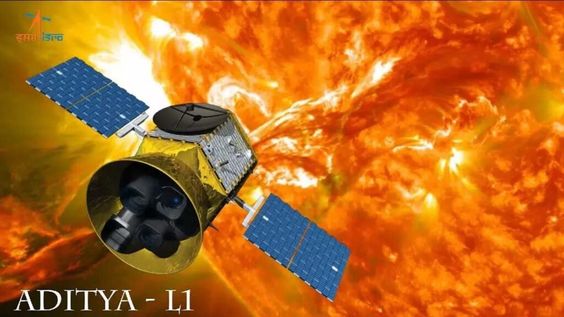Aditya L1 mission launched:
In a remarkable feat of scientific prowess, the Indian Space Research Organization (ISRO) launched the Aditya L1 mission, a solar observatory, into Earth’s orbit. This momentous event follows closely on the heels of Chandrayaan-3’s triumphant landing on the Moon’s south pole.
Aditya L1’s primary mission is to study our closest star, the Sun, and uncover its secrets. Here’s an overview of this groundbreaking mission in four key points:
-
Earth Orbit Exploration (16 Days)
Aditya embarks on its journey by spending 16 days in Earth’s orbit. During this time, the spacecraft will fine-tune its orbit by firing thrusters five times. These adjustments are critical to prepare for the mission’s ultimate destination.
-
The Journey to Lagrange Point-1 (L1)
Following its stint in Earth’s orbit, Aditya will initiate a calculated sequence of thruster firings to make its way towards the elusive L1 point.
Lagrange Point-1 is situated approximately 1.5 million kilometers away from Earth, offering a unique vantage point for solar observations. One remarkable feature of L1 is its freedom from eclipses, allowing uninterrupted solar research.
-
The Path to L1 (110 Days)
Aditya will embark on a 110-day journey, carefully navigating its way to reach a position approximately 110° from Earth towards the L1 point. This meticulous path ensures that the spacecraft is ideally positioned to carry out its solar experiments.
-
Arrival at L1 and Solar Exploration
Once Aditya reaches the L1 point, thrusters will be deployed to insert the spacecraft into a stable orbit around L1.
This strategic placement will enable Aditya to commence its groundbreaking experiments, focusing on the Sun’s various aspects.
A Remarkable Four-Month Journey
Aditya’s epic voyage to reach Lagrange Point-1 will span approximately 125 days, culminating on January 3, 2024. If successful, this mission will mark a significant achievement for ISRO and usher in the new year with a celestial triumph.
Understanding Lagrange Point-1 (L1)
Named after the Italian mathematician Joseph-Louis Lagrange, L1 is one of five such points in the solar system where the gravitational forces of the Earth and the Sun balance perfectly, creating centrifugal force equilibrium. L1, positioned 1.5 million kilometers from Earth, offers the unique advantage of being eclipse-neutral. This allows Aditya to orbit the Sun continuously, providing real-time insights into solar activities and space weather.
Seven Instruments to Decipher the Sun
Aditya L1 carries seven specialized instruments designed to decipher the Sun’s mysteries. These instruments will investigate the solar corona, heating mechanisms, coronal mass ejections, pre-flare and flare activities, particle movements, and space weather, spanning a range of wavelengths and bands.
Indigenous Innovation
Aditya L1 stands as a testament to India’s indigenous capabilities in space exploration. Collaborations between Indian institutions, including the Indian Institute of Astrophysics and the Inter-University Center for Astronomy and Astrophysics Pune, have played pivotal roles in crafting the mission’s payloads.
The Sun’s Vital Significance
The Sun, at the center of our solar system, fuels life on Earth. Its continuous release of energy in the form of charged particles is vital to our existence. Understanding the Sun’s behavior helps us comprehend how solar changes can impact both space and life on our home planet.
Payload Testing Completed
All the instruments on the Aditya L1 satellite, which is heading to observe the Sun, have undergone successful testing.
Studying Solar Coronal Ejections
Aditya L-1 will closely analyze solar coronal ejections, which are bursts of material from the Sun’s upper atmosphere. These ejections can impact our communication networks and electronic activities on Earth.
International Interest in Sun Exploration
Countries worldwide, including the United States, Germany, and the European Space Agency, have launched a total of 22 missions to study the Sun. NASA, the U.S. space agency, has been particularly active, sending the most missions.
Pioneering Sun Missions
NASA started the Sun exploration journey with its first mission, Pioneer-5, back in 1960. Germany joined the efforts in 1974 with its first Sun mission in collaboration with NASA. The European Space Agency followed suit in 1994 with its first mission, also in partnership with NASA.
A Celestial Marvel
The Sun, a colossal celestial body capable of containing 13 lakh Earths, radiates energy equivalent to the explosion of one lakh crore atomic bombs. With an age of 4.6 billion years and a promising future spanning another billion years, the Sun is the life force of our solar system. ISRO’s Aditya L1 mission is poised to embark on this extraordinary journey to unlock the Sun’s secrets, and we eagerly await the revelations it will bring.
Image Courtesy: Google
For more related news – https://universenews.co.in/category/science-technology/
